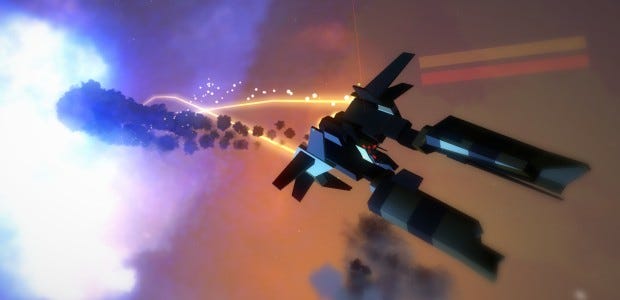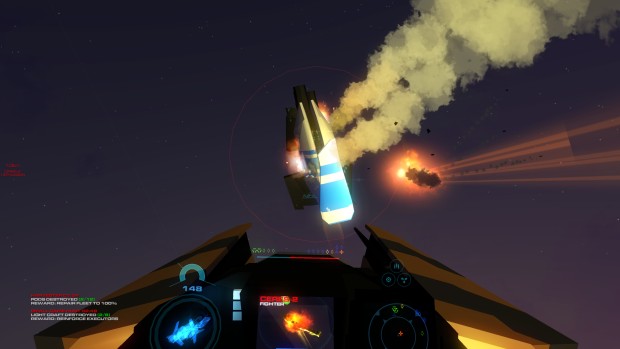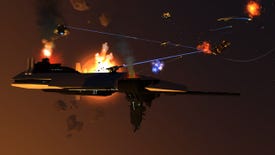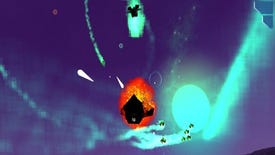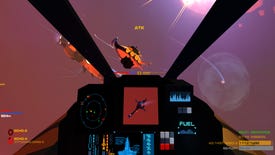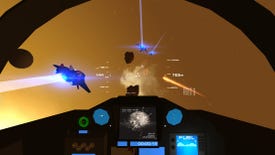Hands On: Enemy Starfighter
The First (Go At) Starfighter
Each game of Enemy Starfighter begins in Overwatch, a region of space from which you can see five or six or seven other possible destinations. Each is represented by a white pip; there's perhaps an asteroid field, a planet, a star, and then one region which has another set of symbols above the white mark. These tell you what ships are inhabiting the space. Corvettes? Frigates? I can never remember what the symbols mean, only that each represents an opportunity for death or derring-do that the dynamic mission generator has created for me.
Pick a destination, engage your gap drive and let's jump into orbit.
Starfighters work in groups, and as I rocket across the solar system I'm flanked on either side by AI-controlled buddies. We arrive in a region near a brown planet some distance from a fleet of capital ships. As they spot us, they release their own set of fighters.
Gap drives are useful not only for leaping between regions of space, but for quickly engaging enemies within those regions. I decide to jump in hot (I always do), so I target one of the distant ships and again engage my drive. My squadmates follow suit. The journey here took thirty seconds and conveyed the scale of the galaxy these fights happen within, but hurtling this short distance to the enemy happens in an instant.
When I exit the slipstream, I have a half-second view of a capital ship before I collide with it and my screen goes black. Lesson learned: don't warp directly at your enemies, but somewhere close to them.
The loss of that ship and pilot doesn't mean the game is over, but that I switch to controlling one of those previously mentioned squadmates. The game only ends when your fleet is entirely depleted, and you can replenish the team with reinforcements by completing bounties within each mission, such as destroying a certain number of smaller ships, or larger ships, or whatever.
When I take control of a new ship, I'm immediately under fire from the scrambled fighters. I lock on to one to fix it on my HUD, and begin to arc and whirl until it's in my sights.
It's sort of unavoidable, given the impending glut of space games, that they be defined in part by their differences. Elite: Dangerous's combat can be fast and chaotic, but it also quickly unfolds to reveal a simple set of possible tactical manouvers. From the cockpit of your Cobra Mk. III, you can shunt power between engines, shields and weapons, to allow you a speedier escape, to mask your ships heat signature, or to overpower an enemy's shields.
Based on a similar amount of playtime, Enemy Starfighter doesn't so immediately offer up an obvious set of tactical options. That's not a criticism, but a shift in focus. Elite: Dangerous makes you feel like your piloting a spaceship. Enemy Starfighter makes you feel like you're piloting a gun.
Those guns feel great to use. You have three to choose from on any given ship: two basic, like a machinegun/shotgun or machinegun/rocket launcher combo; and a heavy weapon like deployable bombs. The shotgun is the best of the bunch, though it may not actually be called that. It fires a flak-cannon style spread that's deadly at close range, and the whole front section of your ship rears back with every shot like the pump of a barrel.
Your attempts at aiming are aided by the game's smart and atmospheric sound effects: when you correctly lead your aim ahead of a speeding opponent, a high-pitched tone will play in your ears to let you know it's time to fire. Combined with muffled engines and the sound of your own pilot's breathing, it makes the experience more engrossing than the abstract art style might imply.
I take out my enemy quickly, then another, then another. Each kill triggers the next target, and occasionally I catch glimpses of my squadmates locked in their own spinning duels, or hear them speak their last words in my ear. The AI mostly does a good job of not getting itself killed, though. A far better job than I.
With the smaller craft dealt with, I turn my attention to the only remaining larger ship. By locking on to it, it's possible to target particular systems, and for example cripple its engines. I haven't yet found much cause to do so, though it has obvious uses. For example, in one life I decided to turn tail and run, leaving a region as the last surviving fighter to see if I could find success somewhere else. The problem being that my opponents followed, using their own gap drives to leap a few seconds after me. If I could have destroyed their engines, that wouldn't have been possible.
I could order my squadmates to attack those engines right now, but I don't. I mainly ignore the nuanced options available in favour of winning through quantity and accuracy. I take aim at the large capital ship in front of me and hold down the fire button, and it's not long before it explodes and breaks apart.
This is an early press build I'm playing, but already Enemy Starfighter is a lot of fun. The combat is good enough that I'd be OK with this being the entire game - a StarFox-ish companion piece to the complexity of Elite and Star Citizen. I don't mean to trivialise its appeal when I say it's the kind of experience I enjoy dipping into for fifteen minute adventures. I feel the same way about Teleglitch, for example.
But given the potential which lies in the underpinning dynamic mission generator, the still-to-come campaign, and the current development roadmap, there's plenty of reasons to think the experience is going to become richer in the near future. Here's the todo list from the readme.txt attached to the build:
- Vary the objectives in each system, your major verb is always "destroy" but there should be more "how" involved in it
- More factions and weapons, both for the Empire (you) and the Federation
- Tie unit experience to new traits, allowing you to field modified veteran units if you keep them alive
- Hook up anchored defenses and structures to landmarks
- Ex: Sentry guns at jump nodes
- Ex: Mining ops at belts
"Tie unit experience to new traits" is the key here, as that seems like the point where the meta-game kicks in and you've more of a reason to remain alive and plan the order of your engagements carefully.
Either way, if you were wondering whether there was room in your life for anticipating another space pilot game, the answer is: make room.
